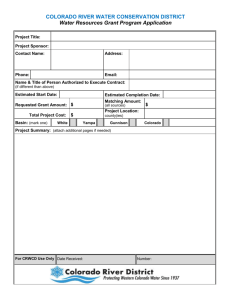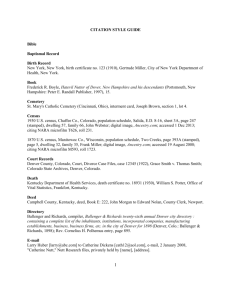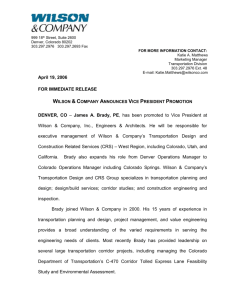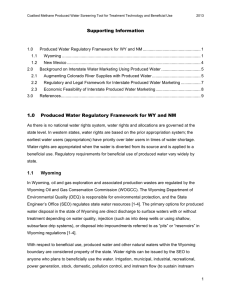view page images in PDF format.
advertisement
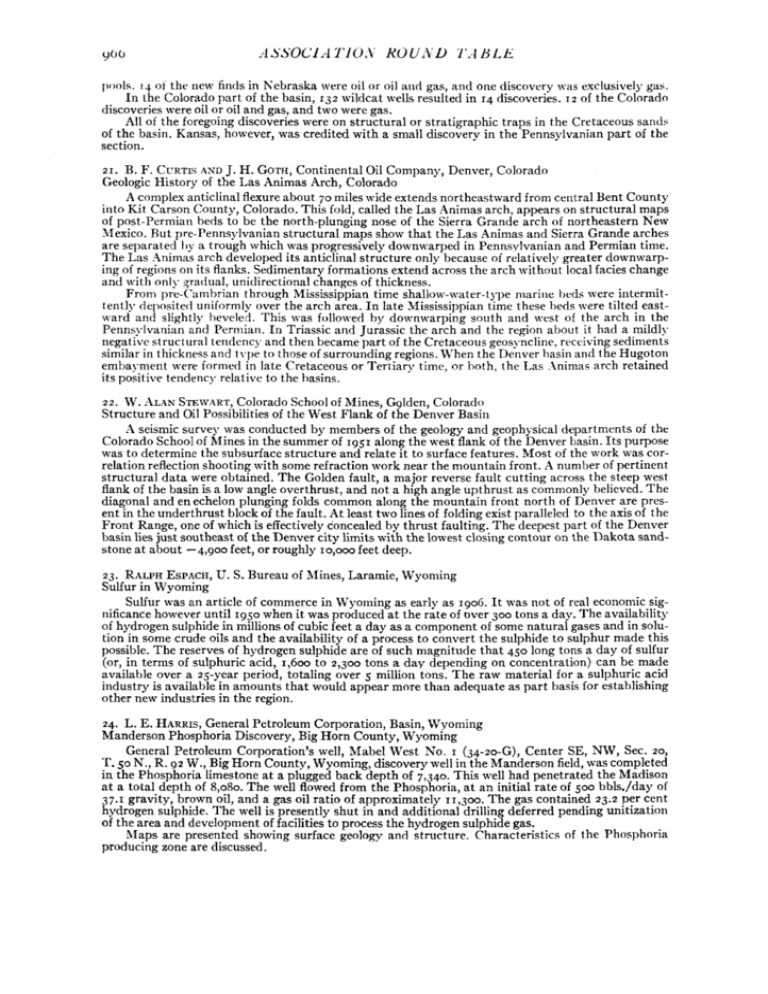
960 ASSOCIATION ROUND TABLE pools. 14 of the new finds in Nebraska were oil or oil and gas, and one discovery was exclusively gas. In the Colorado part of the basin, 132 wildcat wells resulted in 14 discoveries. 12 of the Colorado discoveries were oil or oil and gas, and two were gas. All of the foregoing discoveries were on structural or stratigraphic traps in the Cretaceous sands of the basin. Kansas, however, was credited with a small discovery in the Pennsylvanian part of the section. 21. B. F. CURTIS AND J. H. GOTH, Continental Oil Company, Denver, Colorado Geologic History of the Las Animas Arch, Colorado A complex anticlinal flexure about 70 miles wide extends northeastward from central Bent County into Kit Carson County, Colorado. This fold, called the Las Animas arch, appears on structural maps of post-Permian beds to be the north-plunging nose of the Sierra Grande arch of northeastern New Mexico. But pre-Pennsylvanian structural maps show that the Las Animas and Sierra Grande arches are separated by a trough which was progressively downwarped in Pennsylvanian and Permian time. The Las Animas arch developed its anticlinal structure only because of relatively greater downwarping of regions on its flanks. Sedimentary formations extend across the arch without local facies change and with only gradual, unidirectional changes of thickness. From pre-Cambrian through Mississippian time shallow-water-lype marine beds were intermittently deposited uniformly over the arch area. In late Mississippian time these beds were tilted eastward and slightly beveled. This was followed by downwarping south and west of the arch in the Pennsylvanian and Permian. In Triassic and Jurassic the arch and the region about it had a mildly negative structural tendency and then became part of the Cretaceous geosyncline, receiving sediments similar in thickness and type to those of surrounding regions. When the Denver basin and the Hugoton embayment were formed in late Cretaceous or Tertiary time, or both, the Las Animas arch retained its positive tendency relative to the basins. 22. \V. ALAN STEWART, Colorado School of Mines, Gglden, Colorado Structure and Oil Possibilities of the West Flank of the Denver Basin A seismic survey was conducted by members of the geology and geophysical departments of the Colorado School of Mines in the summer of 1951 along the west flank of the Denver basin. Its purpose was to determine the subsurface structure and relate it to surface features. Most of the work was correlation reflection shooting with some refraction work near the mountain front. A number of pertinent structural data were obtained. The Golden fault, a major reverse fault cutting across the steep west flank of the basin is a low angle overthrust, and not a high angle upthrust as commonly believed. The diagonal and en echelon plunging folds common along the mountain front north of Denver are present in the underthrust block of the fault. At least two lines of folding exist paralleled to the axis of the Front Range, one of which is effectively concealed by thrust faulting. The deepest part of the Denver basin lies just southeast of the Denver city limits with the lowest closing contour on the Dakota sandstone at about —4,900 feet, or roughly 10,000 feet deep. 23. RALPH ESPACH, U. S. Bureau of Mines, Laramie, Wyoming Sulfur in Wyoming Sulfur was an article of commerce in Wyoming as early as 1906. It was not of real economic significance however until 1950 when it was produced at the rate of over 300 tons a day. The availability of hydrogen sulphide in millions of cubic feet a day as a component of some natural gases and in solution in some crude oils and the availability of a process to convert the sulphide to sulphur made this possible. The reserves of hydrogen sulphide are of such magnitude that 450 long tons a day of sulfur (or, in terms of sulphuric acid, 1,600 to 2,300 tons a day depending on concentration) can be made available over a 25-year period, totaling over 3 million tons. The raw material for a sulphuric acid industry is available in amounts that would appear more than adequate as part basis for establishing other new industries in the region. 24. L. E. HARRIS, General Petroleum Corporation, Basin, Wyoming Manderson Phosphoria Discovery, Big Horn County, Wyoming General Petroleum Corporation's well, Mabel West No. 1 (34-20-G), Center SE, NW, Sec. 20, T. 50 N., R. 92 W., Big Horn County, Wyoming, discovery well in the Manderson field, was completed in the Phosphoria limestone at a plugged back depth of 7,340. This well had penetrated the Madison at a total depth of 8,080. The well flowed from the Phosphoria, at an initial rate of 500 bbls./day of 37.1 gravity, brown oil, and a gas oil ratio of approximately 11,300. The gas contained 23.2 per cent hydrogen sulphide. The well is presently shut in and additional drilling deferred pending unitization of the area and development of facilities to process the hydrogen sulphide gas. Maps are presented showing surface geology and structure. Characteristics of the Phosphoria producing zone are discussed.

